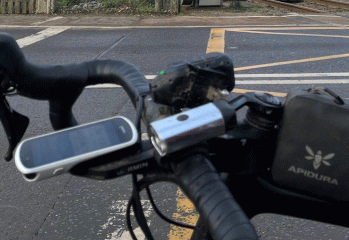Essential equipment list for an audax

There are lots of things to consider bringing on an audax. Most important are the bike setup itself, choice of bags, tools and electronic devices. You should try to bring enough to confidently get you round, but not so much that you're weighed down un-necessarily. But also, don't over-think things or get stressed about whether you're making the right choices! At the end of the day, you will almost always be able to keep moving one way or the other.
The bike
An audax-ready bike will typically not need adjusting between events. It will have a generous range of gears (so a nice big cassette at the back!), have the braze-ons for bolting on extras like bottle cages and pannier racks, and with handlebars set up for a comfortable riding position. Optional extras are:
- Mudguards. Some will argue that these are mandatory, but I play it by ear. However, bear in mind that some event organisers will actually insist on mudguards.
- Aero-bars (tri-bars). Great for efficient riding on open, flatter roads, but not so useful on hilly routes.
- Different tyres. You will normally have standard, tough road tyres fitted, but maybe the route features gravel stretches or back lanes of questionable condition - so wider tyres with a but of tread may be in order.
An ever-increasing problem with bikes is actually the level of sophistication which can make issues impossible to fix at the roadside. Types of modern "improvements" are electronic gearing, internal cable routing, wheels with exotic spoke configurations, and even hydraulic brakes. (The last of these is an extremely robust technology, but if it ever fails then you must find a bike mechanic to sort it.) I'll also mention tubeless tyres as a potential show-stopper, as a tyre split can end a ride if you aren't prepared with an inner tube and the cabability to de-tubeless the tyre! Lots of people swear by tubeless, but I also hear lots of "call of shame" stories when a tubeless setup fails catastrophically.
Bag choice
Carrying stuff is pretty much inevitable in audaxes, so you'll need some bag capacity. This will vary wildly depending on how x-rated the event is, and whether you intend to sleep overnight in an "audax hotel" (a bus-shelter). However, let's stick to the standard one-day audax; for this you'll need capacity for spare clothing, snacks and tools. Personally I stuff spare clothes (such as gloves, arm warmers) in my jersey, carry snacks in a top-tube back, and tools in a saddle-bag. For longer events that may need a change of clothes, I take a bike-pack - basically a very large version of a saddle-bag, capable of carrying a few KGs of stuff.
Tools and spares
I recommend going for the minimum here: a multi-tool with all the hex keys; a decent chain splitter; couple of inner tubes; tube repair kit; pump. A few cable ties are worth bringing along in case something non-structural comes loose. I wouldn't bother with spare spokes or gear/brake cables, as those (in my experience) break fairly rarely. It also pays to think what is involved to replace one of those spares that you've brought along... for example, to replace a rear spoke on the drive side will usually require removal of the cassette, so you'll also need to bring along a chain whip, cassette socket and a wrench, which is a considerable weight penalty!
Electronics
For me the essentials here are my Garmin computer plus front and rear lights (plus spares if night riding is guaranteed). I also bring a battery pack that can charge my phone, plus cables for charging the Garmin and lights. By the way, on longer rides (10 hours or more, or multi-day rides) I will run the Garmin in power-save mode, and this means that it's only around 40 - 50% down for the day.
You may also want to carry a camera or two, to record "interesting" moments on your ride - hopefully lots of good moments, but also those nasties like bad driving. I just have a front-facing camera that I turn on when approaching higher-risk areas like towns and big junctions.
The only other high-tech device I use is a power meter, but that only rarely needs a new battery - and I get a good 10 or so hours advance notice on my head unit that it's running low.
Comments
It's quiet in here...Add your commentGet more out of your power meter!Free sign-up now
Calendar
All Audax: long-distance cycling events | All events

